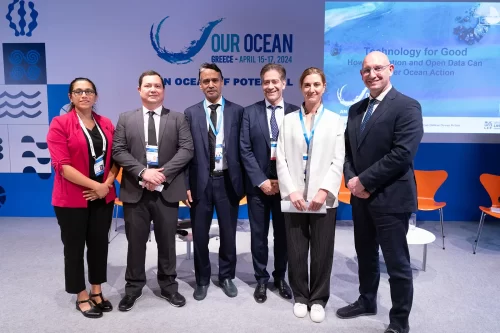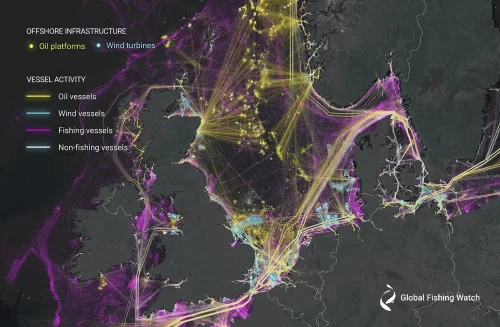New data reveals suspected vessel rendezvous at sea and sheds light on the ‘dark’ fleet
To mark World Oceans Day, Global Fishing Watch (GFW) has increased ocean transparency by releasing the first-ever ‘live’ global view of likely transshipping at sea — a practice that can mask illegal fishing activity, and imagery of night-time fishing and its location, exposing vessels often hidden from other monitoring systems.
Data released on GFW’s map reveals in near real-time the location, time and identity of thousands of vessels involved in close encounters at sea. Fishing boats and refrigerated cargo vessels meet at sea in order to transfer seafood, crew, fuel or supplies. Known as transshipment, the practice enables fishing boats to remain at sea fishing for months to years at a time while still getting their catch to market.
The visualisation is a first step towards greater transparency in transshipping. Under a new grant from the Walmart Foundation, GFW will strengthen this picture with analysis into the supply systems that allow boats to stay at sea for months or years, and a view into where catch is landed from these vessels.
“Transshipment often occurs out of sight and beyond the reach of any nation’s jurisdiction. It’s a weak spot in the monitoring and control of fishing activity and can provide cover for illegal fishing and other unscrupulous activity, including smuggling and human trafficking,” said Tony Long, CEO, Global Fishing Watch. “ We urge governments to embrace transparency in order to strengthen monitoring of transshipment at sea or in port.”
The new data reveals potential transshipment hotspots, which are also visualised in an Oceana report. Vessel encounters cluster at the boundaries of many Exclusive Economic Zones (EEZs), particularly in international waters surrounding Africa, South America and many Pacific nations, just outside their national jurisdiction. They also occur frequently within the EEZs of some west African nations and other regions with laxer management and enforcement. The data does not suggest illegality, but it does reveal a pattern of where transshipment occurs and encourages discussion.
To detect pairs of vessels meeting at sea, GFW and analysts at SkyTruth and Google, applied machine learning algorithms to more than 30 billion Automatic Identification System (AIS) messages from ocean-going boats to find tell-tale transshipment behaviour, such as two vessels alongside each other long enough to transfer catch, crew, or supplies.
AIS is a collision avoidance system that constantly transmits a vessel’s location at sea. These transmissions are collected by satellite receivers and delivered to GFW for automated processing. Nearly all refrigerated cargo vessels carry AIS and those ships receiving fish can be identified and their activity plotted on our map.
“By harnessing big data and artificial intelligence, we’re able to generate a clearer view into the often shady practice of transshipment ,” said Paul Woods, Chief Technology Officer, Global Fishing Watch. “ This data is now freely available to governments, NGOs and academia to use and interrogate, and support global efforts to strengthen monitoring and enforcement to eradicate illegal fishing.”
Lighting up the ‘dark’ fishing fleet with night-time imagery
GFW also today published the location and activity of brightly lit vessels operating at night, the majority of which are fishing vessels. The GFW platform ingests boat detections processed from low light imaging data collected by the U.S. National Oceanic and Atmospheric Administration (NOAA) Visible Infrared Imaging Radiometer Suite (VIIRS). The boat detections are processed in near-real time by NOAA’s Earth Observation Group, located in Boulder, Colorado. The product, known as VIIRS Boat Detections, picks up the presence of fishing vessels using lights to attract catch or to conduct operations at night. More than 85% of the detections are from vessels that lack AIS or Vessel Monitoring System (VMS) transponders.
The satellite-based VIIRS is a constellation of two dishwasher-sized sensors that orbit our planet, capturing visible and infrared light that bounces off the surface of Earth or is emitted by sources on the ground. This instrument has a very sensitive light sensor that is capable of detecting the light emitted at night by a single brightly lit vessel. The VIIRS satellites can image the entire ocean every night.
“Worldwide, the VIIRS satellites are detecting 10-20,000 boats every night that are not broadcasting AIS or VMS. By detecting the signal from lights present on fishing vessels we can calculate a better estimate of the size of certain fleets ,” said NOAA’s Chris Elvidge. “It is clear that VIIRS is detecting vast numbers of fishing vessels that fall below the size limits required to carry VMS or AIS, or they could be larger boats that have turned off their tracking system to avoid detection – both are commonly referred to as the ‘dark’ fleet as they don’t show up in other monitoring systems.”
In Indonesia, NOAA used VMS data to reveal that nearly half of the VIIRS detected boats are purse seine fishing vessels. VIIRS data is revealing fishing grounds that would be missed with just AIS or VMS data. In addition, VIIRS data offers new insights into squid fisheries. Squid jigging most often takes place at night with bright overhead lights to attract the squid. Many squid fisheries globally are overfished and poorly regulated.
In collaboration with GFW, a researcher at the Lima office of the conservation organisation, Oceana, is using VIIRS data to track a fleet of around 200 mostly Chinese vessels fishing for squid at the edge of Peru’s EEZ. By comparing the night imagery with AIS data, the research reveals that about 20% of the Chinese vessels are not broadcasting AIS and may therefore not be operating legally. The imagery also shows several unauthorized incursions by the fishing fleet up to 15 miles within Peru’s EEZ.
“Transparency is entering a new era where it is both possible and expected — consumers demand it, responsible businesses need it, and legal fishing operators only stand to benefit from it ,” added Tony Long. “ At a time of rapid technological innovation and mounting concern about our ocean’s health, we must accelerate efforts to fight illegal fishing and ensure perpetrators have nowhere to hide.”
See video and image assets here

